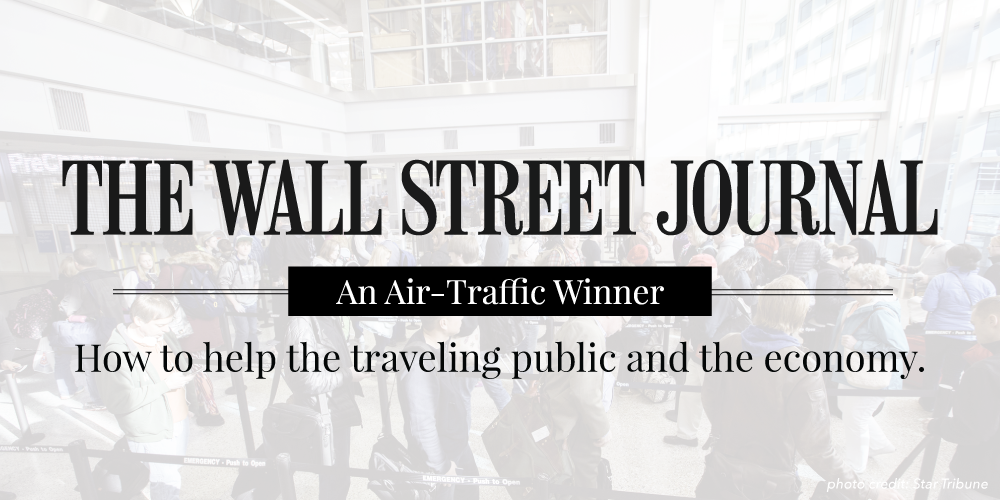Press Releases
ICYMI: WSJ Editorial Board: An Air Traffic WinnerThe House has been working for months behind the scenes on the most significant improvement to commercial air travel in decades: Converting Federal Aviation Administration (FAA) air-traffic control into an operation governed by pilots, airlines, controllers and other industry experts. This would be good news for the economy and the traveling public, if Republicans don’t wig out. House Transportation Chairman Bill Shuster’s legislation would set up a nonprofit entity that manages air-traffic operations, while FAA continues regulating safety and certifying equipment. Instead of taxes, the services would be funded by user fees. This arrangement has allowed Canada to lower levies by about one-third and manage routes and landings more efficiently. Canada’s air-traffic outfit even sells technology to other countries.
How to help the traveling public and the economy. Editorial Board The House has been working for months behind the scenes on the most significant improvement to commercial air travel in decades: Converting Federal Aviation Administration (FAA) air-traffic control into an operation governed by pilots, airlines, controllers and other industry experts. This would be good news for the economy and the traveling public, if Republicans don’t wig out. House Transportation Chairman Bill Shuster’s legislation would set up a nonprofit entity that manages air-traffic operations, while FAA continues regulating safety and certifying equipment. Instead of taxes, the services would be funded by user fees. This arrangement has allowed Canada to lower levies by about one-third and manage routes and landings more efficiently. Canada’s air-traffic outfit even sells technology to other countries. For years the Inspector General of the Transportation Department has been the official biographer of the FAA’s failures in overhauling radar technology that dates to World War II. The tales include tech updates that are billions over budget and a decade late. One microcosm: An IG report from 2014 noted that FAA had implemented 51 initiatives to boost controller productivity, improve best practices and cut costs. Only two produced discernible savings. Six increased costs, and no one can be sure what the other 43 did. A version of Mr. Shuster’s plan stalled in the House last year amid objections from the general-aviation community, which is now trying to shoot down this year’s draft. Yet the bill exempts hobbyists from paying user fees and explicitly bans the air-traffic operation from restricting air space. GA outfits have also pumped specious national-security concerns, even as Defense Secretary Jim Mattis has welcomed the spinoff. One overwrought objection was that the bill would be a big business giveaway to major airlines, which would have had four representatives on the governing board. The revised bill grants airlines one seat and adds representation for cargo and regional airlines, as well as airports. Robert Poole, the intellectual force behind the idea who supported the first version, calls the new bill a “big improvement.” Another concern is that rural airports will be closed or harmed, though the bill maintains subsidies for remote areas, which is lamentable if a political reality. A Reason Foundation report details how FAA after the 2013 budget showdown put a moratorium on new contract towers that can benefit small airports, which will never beat out JFK or San Francisco International for FAA dollars. Under a new arrangement, rural airports could explore technology like remote towers, which allow controllers to manage operations with sophisticated cameras and communication equipment. Many of these complaints come from the unprotected class of Americans known as corporate-jet passengers. The National Business Aviation Association is opposing the bill even though it exempts business jets from paying more in fees. That dispensation is regrettable. If the proletariat sitting in steerage pays for air services, so should a CEO flying across the country for lunch. The irony is that corporate-jet users are the least price-sensitive passengers and put a high value on time. Wouldn’t many executives happily pay extra for a faster landing and shorter lines on the tarmac? NetJets to its credit seems to recognize these realities and endorsed the bill this month. All of this will be litigated in the Senate if the bill passes the House, where proponents are whipping support. But in the upper chamber the idea is opposed by Kansas Sen. Jerry Moran, who wields a deciding vote on the committee that oversees transportation. Mr. Moran thinks he’s protecting his home state aviation lobby, though more efficient air space would benefit the entire industry. Republicans should seize the moment because they have a President who wants reform as part of his infrastructure upgrade. Mr. Shuster is willing to negotiate, and the House has done the leg work. The biggest hurdle may be convincing appropriators to relinquish control over billions in air-travel tax revenue they now redistribute. By the way, a new air-traffic entity would reduce the number of federal employees by more than 30,000 and federal spending by billions of dollars. The perception that the government has become too large to even know what it manages is one reason voters gambled on Donald Trump. Modernizing the human misery known as U.S. air travel should be a bipartisan win. |








